
The Lake Michigan shoreline at Illinois Beach State Park in Lake County. All photos by the author.


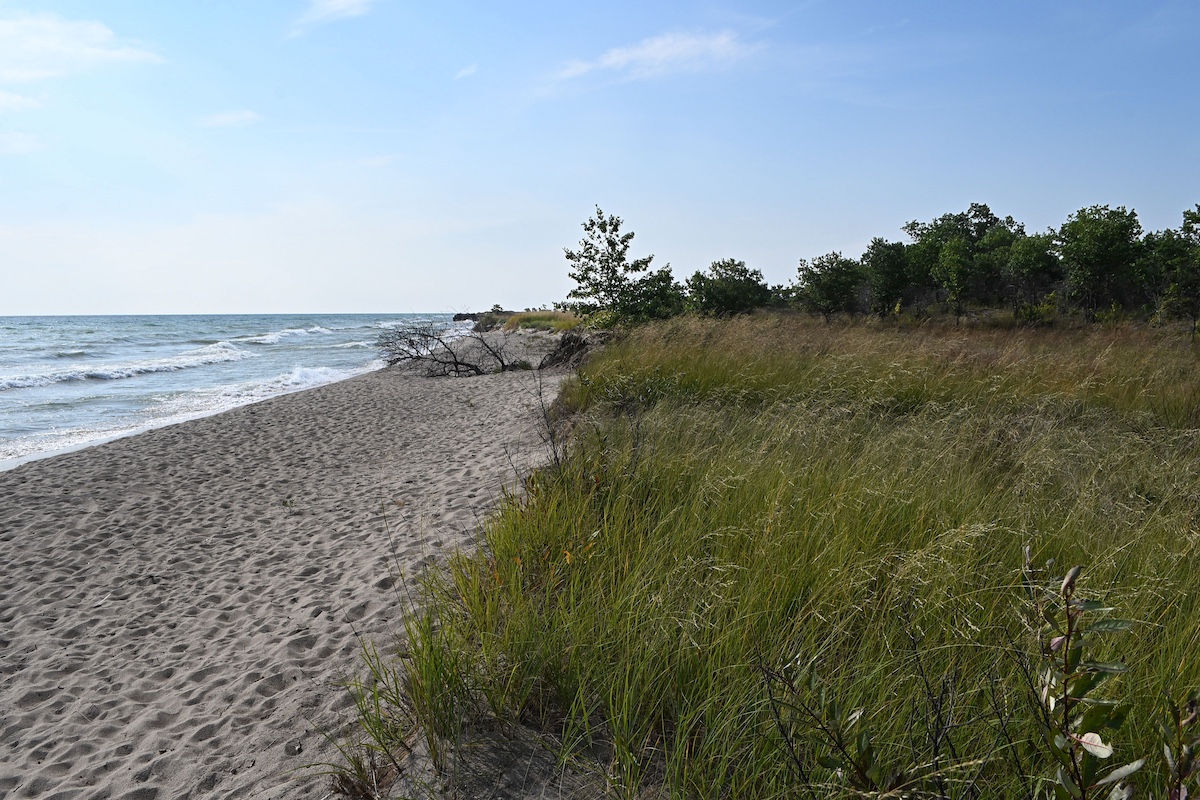

The Lake Michigan shoreline at Illinois Beach State Park in Lake County. All photos by the author.
Walking along the dunes at Illinois Beach State Park (IBSP), I am transported back in time. These tall grasses offer a glimpse of what these prairies may have looked like 200 years ago.1, 2, 3 It is a wild, beautiful landscape that makes me feel tiny.
Illinois Beach State Park is a long, narrow strip of land along approximately 6 miles—10 percent of the Illinois shoreline—of the shore of Lake Michigan in Lake County. It is divided into two “units,” the North and the South, by the out-of-commission Zion nuclear power plant. The South Unit begins about 45 miles north of Chicago, and the North Unit’s North Point Marina property touches the border of Wisconsin. The Illinois Department of Natural Resources’ portion of lake shore is relatively undeveloped, consisting of natural beaches, dunes and some old shoreline stabilization features from the past. The latest features to capture a visitor’s eye will be a series of offshore rock structures designed to reduce wind and wave induced shoreline erosion. These structures were completed in 2023 and are designed to promote natural beach dynamics of wind and wave action.
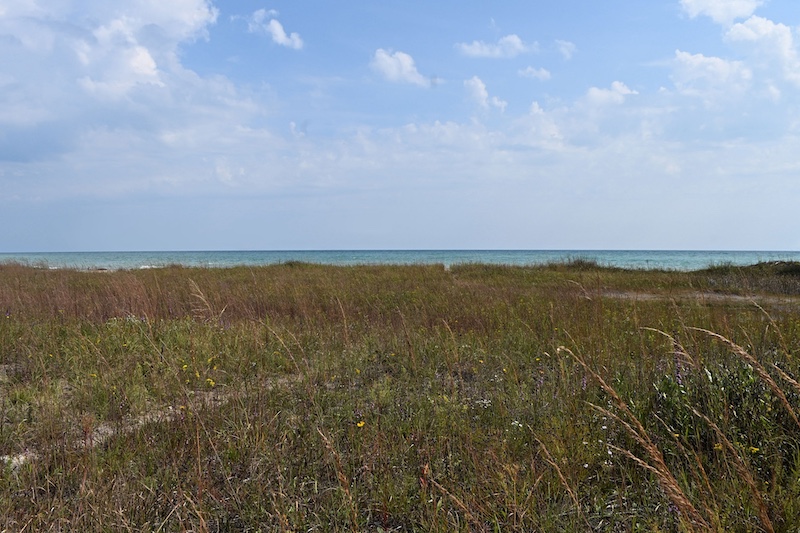
My first encounter with IBSP was in the book Plants of the Illinois Dunesland by Elizabeth T. Lunn.1 I came across it a few years ago in the Lendhardt Library at the Chicago Botanic Gardens. Published in 1982, it is a thin book that organizes plants by type and color and uses large photographs that are perfect for a newbie like me who was just starting to learn about native plants.
I remember being surprised by the diversity of plants found at the park. Up until that pivotal point, I had thought of Illinois as little more than a series of cornfields, suburbs and industries. How terribly wrong I was.
I made my first visit to IBSP one sunny Saturday morning, early in the spring of 2019. At more than 4,160 acres, the park is a mighty presence along the lakeshore. I saw sandy tallgrass prairies juxtaposed by rolling dunes and ridges that walled off the lake from the rest of the park. Sandhill cranes visited the sand oak savannas. A family of beavers went about their business in the Dead River. Dragonflies hovered above the marshes and swales, with the sounds of frogs chorusing.
Since then, I have spent a lot of time exploring and volunteering at IBSP. I know where to find the patch of bloodroots flowers that bloom in early spring, the prickly pear plants that flower a brilliant yellow during the summer, and the cerulean-colored horizontal junipers that crisscross the shiny bright-red bearberries bushes across the dunes.

My favorite time of year is late summer and early fall when the prairie grasses reach the sky and take on breathtaking shades of shimmering reds, coppery oranges and blue hues. There is one path, in particular, where it is perfect for seeing the grasses. The sandy path is surrounded by native plants and offers a straight hike to the water. Many visitors may never notice the grasses as they stroll to the beach. Among so many other flowering plants, it is as if they are hidden in plain sight. There are purple blazingstars, tall western sunflowers and winding bindweed flowers along the path. Goldenrods lean away from the breeze and stand among yellow false foxgloves. Tiny white flowers cover flowering spurge plants, with rose hips visible low to the ground in striking contrast to the last of the purple prairie clovers of the season.

On closer examination, however, I begin to spot grasses – little bluestem, big bluestem and Indian grass. They are sparsely distributed – until I reach a crossroads, where the landscape dramatically changes. There, in both directions, I will be surrounded by grasses; the dune grasses straight ahead, towards the beach, and the tall grasses off to my right.
Neither the dune grasses nor the prairie grasses resemble those varieties of grass that make up our lawn and golf courses. There is a real disconnect in how strongly we associate grasses with our suburban landscapes that may undermine how we understand, appreciate and care for these native species.
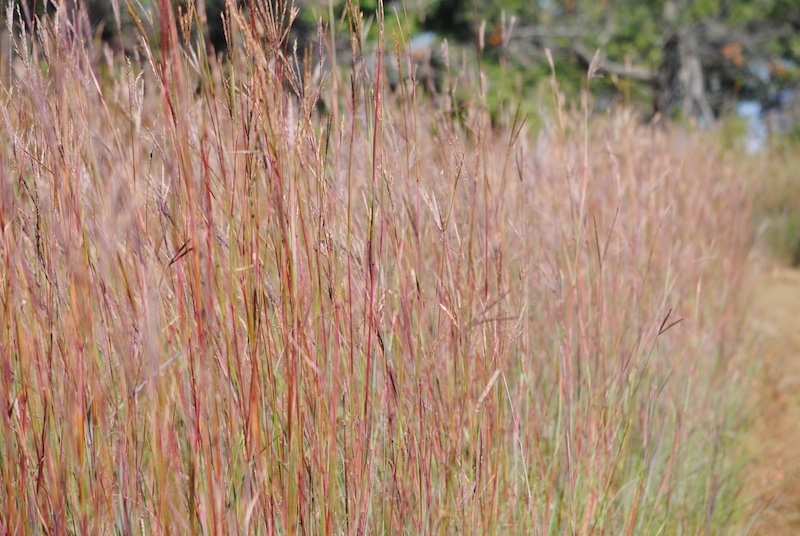
There is much more to the grasses at IBSP than meets the eye. They have deep, extensive root systems that can reach as far as 12 feet below ground.2, 4 The seeds of native grasses are usually dispersed by the wind and do not require pollinators. So, at first glance, they may not be as striking as their forb counterparts. Still, up close, these grasses are stunningly delicate with vivid colors.
As I walk towards the beach and the dune grasses, there is a slight incline, and the density of plants quickly drops, resulting in less protection from the cool winds. This part of the park has changed drastically since my initial visit, and sections are unrecognizable to me. The dunes are eroding at an unsettling pace. Although there is an innate tendency for dunes to constantly change, this feels different. The erosion is cutting into the foredunes and removing entire groups of plants, as evidenced by fallen trees and exposed roots that cling to the crumbling sand. I no longer always see the clear distinct patterns of plant growth that are expected.5, 6 Instead, there is a patchwork of plants considered pioneers, or the first to colonize an area.
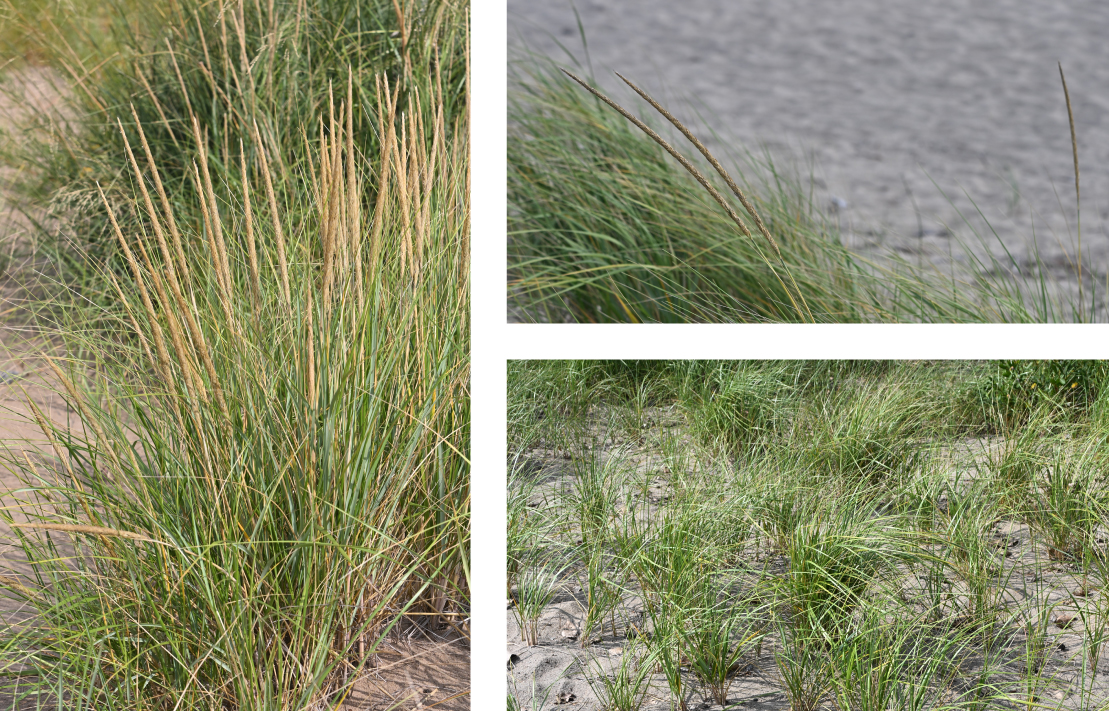
I chose an area where the foredunes are still intact. From this position, I look down at the waves crashing on the beachline. There, plants have to withstand cutting winds, extreme weather and shifting sand.5, 6
Marram grass, sometimes called beach grass, is considered by many as the most important of these perennial plants.5 Above ground, marram grass will grow in small clumps, up to 4 feet. The leaf blade is narrow and approximately 2 feet long.7 Leaves reach out then fold over creating circular shapes across the dune. The stalk of the flower head, in comparison, remains straight and has an elongated ochre-colored spike that feels deceivingly silky.
It is below ground where the real magic happens. Marram rhizome roots can spread 20 feet in all directions forming an extensive root system. This “dune builder” grass can endure long periods of drought and has an important role in stabilizing the dunes, and helping to set other plants up for success by building nutrients in the sand.5
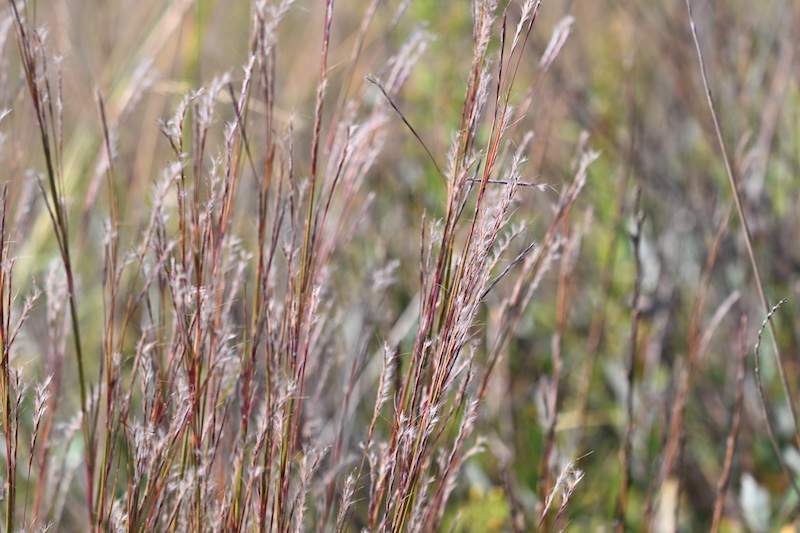
Intertwined throughout the marram grass, are clusters of little bluestem grass. In late fall, the stems of the little bluestem have turned an iridescent burgundy and white feathery seeds are visible in a raceme arrangement at the top of the stalks. Little bluestem grass is not a dune builder nor specific to the dunes yet still important for the early dune building.5
I was fortunate enough to collect seeds from little bluestem grasses on a volunteer day at IBSP. Those seeds will be used for future dune and prairie restoration.

We collected seeds in late fall. Those early mornings are chilly and brisk, but the cold air wakes me up. At that time of day, it is quiet, except for the rhythmic sound of the waves. I was handed several empty bags, each of which was used for a different plant: reed grass, blazingstar, little bluestem and purple prairie clover.
Little bluestem was my favorite. I would run my hand up the inflorescence, the seeds bunching in my hand and feeling like cotton. I would take a third of the seeds and return the rest back to nature by tossing them to the ground. My shoes left soft imprints in the sand as I carefully tread between marram grasses, little bluestems and horizontal junipers that zig zagged across the dunes. By early afternoon, my bags were filled with precious fluff. Not a bad way to spend an early Saturday morning.
Descending from the dune, I backtrack to the crossroads and turned left, leaving the marram grass behind me. From a distance, I saw the tallgrasses—little bluestem, big bluestem and Indian grass—many towering high above me. It is impressive.
Big bluestem and Indian grass are iconic tallgrasses and easily identifiable.8, 9 Big bluestem are bluish-purple in color late in the season and have iconic turkey feet-like inflorescences with dangling red anthers. The turkey feet seem flattened as if pressed between two heavy books. Indian grass has a closely packed, deep golden to bronze flower spike that flows over like a waterfall.
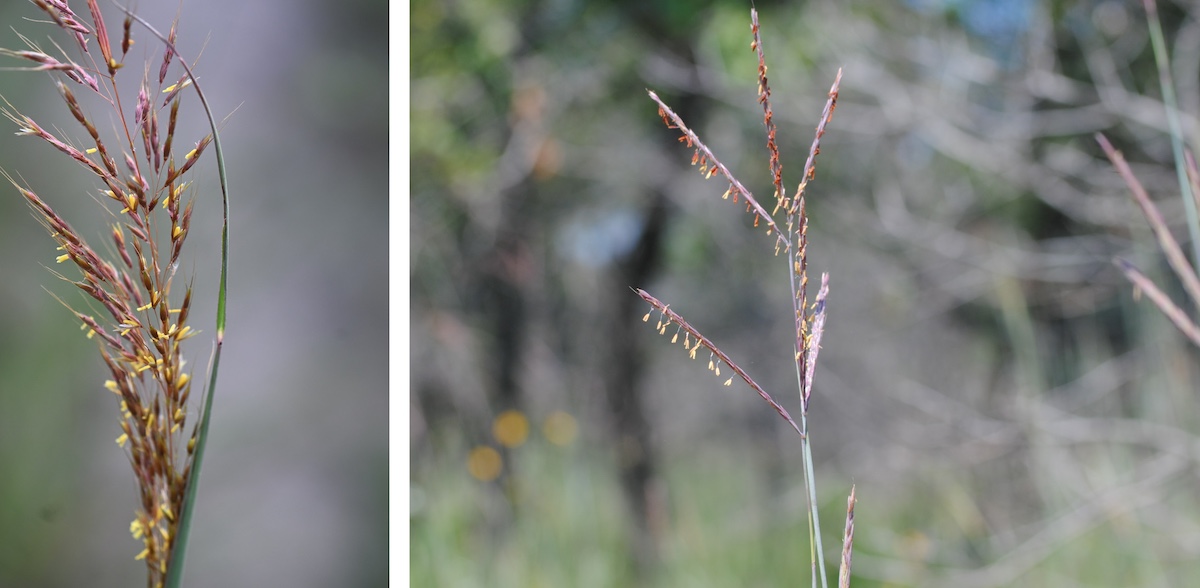
IBSP belongs to the tallgrass prairie system that once covered much of Illinois, as opposed to the mid and short grass prairies which are found west of the state.2 As their name suggests, tallgrasses at maturity can grow up to 5 to 10 feet in height.2
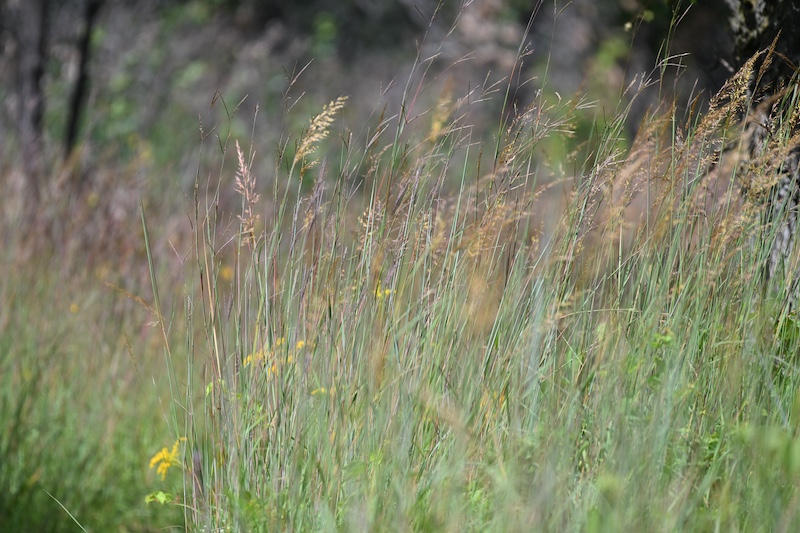
In 1820, more than 60 percent of the state, or 22 million acres, was covered with prairies. The first Europeans to settle Illinois described the land as “a sea of grass.”3, 11 It is difficult for me to wrap my mind around that image – a sea of grass the size of an entire state.11 Today, of those 22 million acres of prairie, only 2,000 acres of high-quality prairies remain.3
For a moment, I, too, am lost in a sea of grasses, gently swaying like waves of the ocean. I peek through to glimpse at western sunflowers and blazingstars, drowned by all the colors.
I am not alone. The dragonflies create black clouds as they weave in and out of the grasses, and the crickets are in a perpetual hopscotch battle. I hear white-throated sparrows singing and notice a monarch hanging on to a blazingstar. Native prairie grasses provide food, habitat and shelter for insects, birds and mammals.2, 9, 11

To maintain the prairies, human intervention is required. Annual prescribed burns (controlled fires) prevent trees and shrubs from taking root and overtaking the prairies. Fire will also remove invasive plant species, prevent wildfire from spreading and recycle nutrients back to the soil.12, 2 There is a significant difference in quality between prairies that receive annual burns and those that do not, as measured by the number of insects that colonize the plants.13
Native grasses play an essential role in establishing and maintaining the dunes at Illinois Beach State Park, which, in turn, provide habitat for a wide range of creatures.
Native grasses have an understated beauty and are important to Illinois’ past as the “Sea of Grass,” to enhancing the quality of life today and as a habitat worthy of protecting for future generation.
Sima Dinesh Shah is an illustrator, printmaker and nature journalist. She resides in Chicago. In 2020, Shah received her certificate in Traditional Botanical Art from the Chicago Botanic Garden. She is a novice but avid birdwatcher, hiker and native plant enthusiast. You can learn more about Sima and her work on her website.
Submit a question for the author